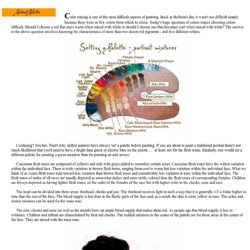

Skin Tone Painting Tips. Add your own skin-tone-mixing tips here...

I'm not a portrait artist, but one of the projects I set in my Painting I class is to paint a portrait from a photograph. I teach students a very-simple-to-remember "recipe" using approximately seven parts white (I prefer flake white because it's warmer), one part yellow ochre, and a pinch of cadmium red light (about the equivalent to two tenths of one part). For shadows I encourage them to experiment, but using more yellow ochre and cadmium red will gradually darken the skin tones. For more drastic and darker shadows I suggest adding burnt sienna and/or burnt umber and even a little alizarin crimson. For darker skin tones I usually suggest using burnt and/or raw sienna (depending on how "red" the color of the skin might be) and green (the green usually suggested is viridian, but, again, I encourage experimenting until they find something they like).
Here is my best 'recipe' for flesh tone colors: 1. Tip from: Monique Simoneau. Painting skin tones in oils. I don't think there are any real set formulas for painting skin colours, it's a matter of observation and relating one colour to another.

I usually use (not that I do it very often!) A fairly limited palette with a couple of warm and cool reds and yellows, a green and perhaps ultramarine. At the portrait workshop the other day with Susan Cesarini, she spent some time discussing colour mixing and I thought it might be useful to post some notes from that, the colours she prefers, and a photo (sorry not the clearest) of a chart showing colour mixes. The colours used Viridian, Terra Rosa, Cad red, Alizarin Crimson, Yellow Ochre(pale) Cad yellow, Titanium White. (Burnt sienna and Ultramarine are on the chart, but it's just a matter of the situation) Mixing colours for flesh tones, some suggestions..
Simple mixes from a limited palette are usually the best, and to avoid colours becoming muddy it’s best to use a maximum of three colours plus white. Mixing lights, begin with white and add colour. Skin tones for painting. C olor mixing is one of the most difficult aspects of painting.

Back in Holbein's day it wasn't too difficult simply because there were so few colors from which to chose. Today's huge spectrum of colors makes choosing colors difficult. Should I choose a red that stays warm when mixed with white or should I choose one that becomes cool when mixed with white? The answer to the above question involves knowing the characteristics of more than two dozen red pigments - and five different whites. Confusing? Caucasian flesh tones are composed of yellows and reds with greys added to neutralize certain areas. The head can be divided into three areas: forehead, cheeks and jaw.
The ears, cheeks and nose (as well as the mouth) have an ample blood supply that makes them red. The area under the nose - the jaw, has the most neutral color. The neck should be slightly neutralized. The following illustrations were sketched out in gouache rather than oils but the same principles apply.